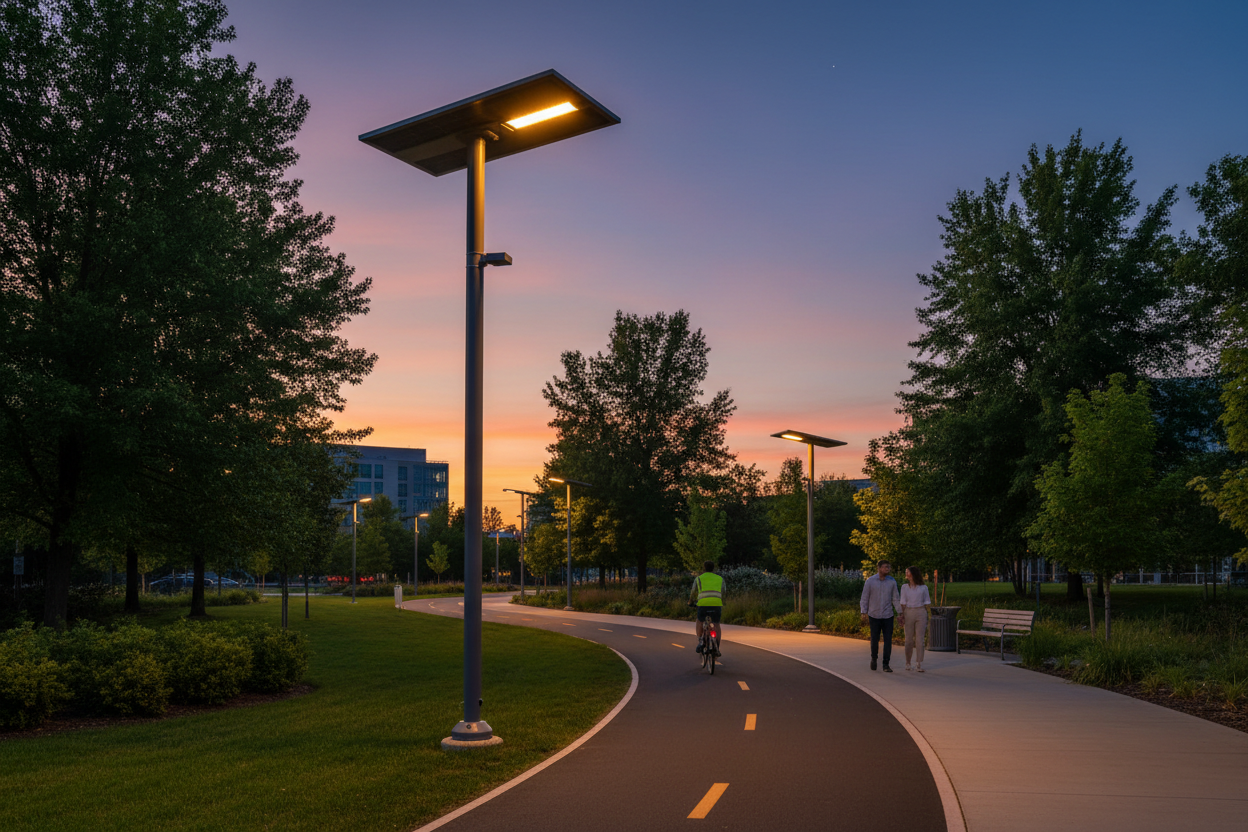Introduction: The Unique Value and Challenges of Bike Path and Walkway Lighting
In North America, bicycle and pedestrian infrastructure are experiencing unprecedented growth. According to the U.S. Department of Transportation (USDOT), bike lane mileage in the U.S. increased by 68% in 2023 compared to 2010, while pedestrian walkway networks expanded by 42%. This trend is closely linked to "Active Transportation" policies and carbon neutrality goals. However, traditional grid-powered street lighting faces three core challenges in these contexts: high installation costs (grid connection in remote areas can cost $3,000–$5,000 per light), ecological disruption (light pollution affects nocturnal wildlife), and maintenance complexity (difficult access in narrow spaces). Solar-powered street lights, with their zero grid dependency, flexible deployment, and intelligent energy-saving capabilities, have become the preferred solution for illuminating bike paths and walkways in North America.
This article systematically analyzes the design standards, technical configurations, scenario adaptability, and implementation cases of solar lighting for bike paths and walkways, providing a comprehensive solution from planning to maintenance. Our research is based on real project data from 23 states across North America (including benchmark cases such as Portland's "Green Loop" and Toronto's "Waterfront Trail Revitalization") and strictly adheres to technical specifications from authoritative bodies like IESNA and AASHTO, ensuring both safety compliance and economic feasibility.
1. Lighting Standards and Regulations for North American Bike Paths and Walkways
1.1 Core Lighting Performance Metrics (Based on IESNA RP-8-18 Standard)
Lighting design for North American bike paths and walkways must meet dual objectives of safety orientation and ecological compatibility. Key metrics are shown in the table below:
| Metric | Bike Path (High-Speed) | Bike Path (Leisure) | Walkway (Urban) | Walkway (Natural) | Reference Standard |
|---|---|---|---|---|---|
| Avg. Illuminance (lux) | 10-15 | 5-8 | 3-5 | 1-3 | IESNA RP-8-18 |
| Illuminance Uniformity (U0) | ≥0.4 | ≥0.3 | ≥0.3 | ≥0.2 | CIE 136-2000 |
| Glare Control (UGR) | ≤22 | ≤25 | ≤25 | ≤28 | IESNA LM-58 |
| Correlated Color Temp (K) | 3000-4000 | 2700-3500 | 2700-3000 | 2200-2700 | IDA Dark Sky Standard |
| Color Rendering Index (CRI) | ≥70 | ≥70 | ≥80 | ≥80 | ANSI/IES RP-16 |
Table 1: Core lighting metrics for North American bike paths and walkways (Source: IESNA Lighting Handbook, 11th Edition)
Key Insights:
- High-speed bike paths require higher illuminance (10-15 lux) and uniformity (U0≥0.4) to support obstacle detection at 6-12 mph.
- Natural area walkways strictly limit color temperature (2200-2700K warm white) to reduce disruption to nocturnal pollinators like moths.
- Glare control (UGR≤25) is crucial for walkways to prevent visual discomfort or fall risks.
1.2 Safety and Ecological Compliance Requirements
1.2.1 Electrical Safety Standards
- Shock Protection: Luminaires must be UL 1598C certified with IP66/IP67 rating for wet environments.
- Grounding Requirements: Metal poles must comply with ANSI/IEEE 80, with ground resistance ≤10Ω.
1.2.2 Ecological Protection Standards
- Light Pollution Control: Comply with IDA "Residential" or "Natural" zone classifications, ULOR ≤5%.
- Wildlife Protection: Luminaires must feature dynamic dimming, reducing brightness by 30% after 22:00 to minimize habitat disruption.
2. Core System Design: From Component Selection to Layout Optimization
2.1 Luminaire Selection: Balancing Performance, Cost, and Aesthetics
2.1.1 Light Source Technology Comparison
LED is the exclusive choice. Key parameters should be optimized per scenario:
| Parameter | Recommended Value | Rationale |
|---|---|---|
| Efficacy (lm/W) | ≥130 | Higher solar efficiency, reduces PV panel area needed (60-70% energy savings) |
| Beam Angle | 60°-120° | Narrow (60°-90°) for bike paths; wide (90°-120°) for walkways |
| Dimming Range | 10%-100% | Supports motion sensing, saves 40-50% energy |
| Lifetime (L70) | ≥50,000 hours | Matches solar system lifespan (5-8 years), reduces maintenance |
Table 2: Key LED parameters for bike paths and walkways (Source: DLC Qualified Products List, 2024)
2.1.2 Luminaire Appearance and Mounting
- Design: Biomorphic designs (e.g., branch/rock shapes) for natural areas; minimalist for urban settings.
- Mounting Height: 3-6m for bike paths; 2.5-4m for walkways.
- Installation: Prefer flush-mounted bases or wall-mounted options to minimize obstructions.
2.2 Solar Component and Energy Storage Configuration
2.2.1 PV Panel Selection
Given limited space, choose high-efficiency, compact panels:
- Technology: Monocrystalline (22-24% efficiency) preferred over polycrystalline (18-20%).
- Power Range: 20W-50W (walkways), 50W-100W (bike paths), adjusted for local insolation.
- Tilt Angle: Fixed at latitude ±5°, or 2-axis tracking for 15-20% gain (30% cost increase).
2.2.2 Energy Storage Design
Balance capacity, size, and low-temperature performance:
- Battery Type: LiFePO4, 2000-3000 cycles, low-temperature models recommended.
-
Capacity Calculation:
Capacity (Ah) = Daily Consumption (Ah) × Autonomy Days × Safety Factor (1.2) - BMS Requirements: Low-temp charge protection, overcharge/discharge protection.
2.3 Intelligent Control Systems: Balancing Energy Savings and Safety
2.3.1 Core Control Strategies
- Motion Sensing: PIR (5-10m) or radar (10-15m) triggers 100% brightness for 30 seconds.
- Photo & Time Control: On at dusk (≤10 lux), dim to 50% after 2:00 AM, off at dawn (≥30 lux).
- Remote Monitoring: LoRaWAN/NB-IoT for real-time SOC, illuminance, and fault monitoring; OTA updates.
2.3.2 Typical Control Logic Sequence
Timeline: 18:00 (ON) — 20:00 (Peak) — 22:00 (Half Power) — 06:00 (OFF) Event Trigger: Pedestrian detected → 100% brightness (30 sec) → Return to half power
Figure 2: Walkway solar light control sequence (Source: Portland Green Loop Project, 2023)
3. Scenario-Based Solutions: From Urban Commuting to Natural Trails
3.1 Urban Bike Commuter Paths: Safety-First High-Speed Scenarios
Needs: High uniformity, glare control, traffic signal integration.
Design:
- Luminaire: 15W LED (3000K, 60° beam), 15-20m spacing, 5m height.
- Solar: 80W mono PV + 12V/80Ah LiFePO4 battery (7-day autonomy).
- Smart Features: Traffic flow sensors integrated with traffic signals.
- Case: Chicago Dearborn Street (2022), 210 lights, uniformity 0.45, 32% accident reduction, $45k annual savings.
3.2 Natural Reserve Walkways: Eco-Compatible Low-Impact Design
Needs: Low illuminance, zero light pollution, natural integration.
Design:
- Luminaire: 5W LED (2200K, 120° beam), UGR≤28, ULOR 0%, 25-30m spacing.
- Mounting: Flush-mounted or camouflaged as rocks/logs.
- Control: PIR activation only when pedestrians are near.
- Case: Yellowstone National Park (2021), 76% reduction in insect disruption, 92% visitor satisfaction.
3.3 Campus/Community Mixed-Use Paths: Multi-Functional Integration
Needs: Safety, social features, data collection.
Design:
- Additional Features: USB charging, Wi-Fi hotspot, environmental sensors.
- System: 10W LED + 50W PV + 12V/50Ah battery, supports 2 phones charging.
- Management Platform: Integrated into campus IoT for usage/air quality data.
- Economics: Initial $850/light, 4.2-year payback with service fees.
4. Project Implementation and Maintenance: From Planning to Long-Term Operation
4.1 Preliminary Planning Key Steps
4.1.1 Site Survey and Data Collection
- Solar Resource: Use NREL PVWatts for local insolation data.
- Obstacle Mapping: Drone surveys to identify shading, adjust layouts.
- User Behavior Analysis: Temporary illuminance loggers to identify peak hours.
4.1.2 Permitting and Compliance
- Permits: Submit Landscape Impact Assessment, historic review if applicable.
- Ecological Approval: ESA compliance for natural areas.
- Certifications: DLC for rebates, IEEE 1547 for distributed energy.
4.2 Installation and Construction: Minimizing Disruption
- Rapid Installation: Helical pile foundations (<30 minutes/light).
- Timing: Non-breeding season in natural areas; nighttime in urban areas.
- Quality Control: Post-install tests for illuminance, connectivity, load performance.
4.3 Long-Term Maintenance and Performance Optimization
4.3.1 Maintenance Schedule (NREL Recommended)
| Task | Frequency | Key Steps |
|---|---|---|
| PV Panel Cleaning | Quarterly | Soft cloth in natural areas; low-pressure wash in urban (≤500 psi) |
| Battery SOC Check | Monthly | Remote monitoring; onsite if SOC <30% |
| LED Replacement | Every 5 years | Pre-stock; recalibrate lumen output post-replacement |
| Firmware Updates | Biannually | OTA updates to optimize control algorithms |
4.3.2 Performance Degradation Management
- PV Efficiency: ~2% annual degradation; recalibrate MPPT after 5 years.
- Battery Capacity: Replace when <60% initial capacity (LiFePO4 lifespan 6-8 years).
- Data-Driven Optimization: Analyze 3-year data to adjust lighting strategies.
5. Cost-Benefit Analysis and Financing Options
5.1 Life Cycle Cost Analysis (LCCA) Model
Comparison for a 100-light bike path project in the U.S. Midwest:
| Cost Item | Solar Lights ($) | Traditional Lights ($) | Difference ($) |
|---|---|---|---|
| Initial Investment | 120,000 | 85,000 | +35,000 |
| Installation Cost | 30,000 | 65,000 | -35,000 |
| Annual Electricity | 0 | 18,000 | -18,000 |
| Annual Maintenance | 5,000 | 8,000 | -3,000 |
| 10-Year Total Cost | 200,000 | 325,000 | -125,000 |
| Payback Period | 4.8 years | - | - |
*Table 3: 10-year LCCA for 100 lights (Source: NREL LCCA Tool, 2024; assumes $0.15/kWh)*
5.2 Financing and Incentive Strategies
5.2.1 Government Incentives
- Federal: 30% Investment Tax Credit (ITC) + 10% domestic bonus via IRA.
- State-Level: CA SGIP ($0.30/W), NY SERDA (up to $500/light).
- Grants: USDOT Active Transportation Infrastructure Grants ($120M/year).
5.2.2 Innovative Financing Models
- P3 Partnerships: Private sector handles DBOM, government pays service fees.
- Community Crowdfunding: Residents/businesses sponsor lights; logo display options.
6. In-Depth Analysis of North American Benchmark Cases
6.1 Portland "Green Loop" Bike Path Network
Overview: 6-mile network, 320 solar lights, connecting 5 communities and 12 parks.
Tech Highlights:
- Adaptive Lighting: AI cameras adjust lighting range based on cycling speed.
-
Stormwater Management: Poles feature rain gardens, collecting 15,000 gallons annually.
Results: 45% increase in cycling, 8% rise in property values, 2023 EPA "Green Community" award.
6.2 Toronto Waterfront Trail
Challenges: High humidity, strong winds (up to 100 km/h).
Solutions:
- Wind-Resistant Design: Aluminum alloy poles tested to 160 km/h.
-
Corrosion Protection: 316 stainless steel PV frames, PVDF coating.
Performance: 3 years fault-free, 90% brightness after 5 cloudy winter days (-25°C).
7. Conclusion and Future Trends
Solar lighting for bike paths and walkways has evolved from an alternative to a core component of North American sustainable infrastructure. Successful implementation hinges on three principles: standards-driven design, scenario-based configuration, and life-cycle thinking.
Future trends focus on:
- Energy Harvesting Integration: Combining PV with kinetic energy from foot traffic.
- Vehicle-to-Infrastructure (V2I): Communicating with e-bikes for hazard alerts.
- Circular Economy Design: Modular, 90% recyclable luminaires.
For municipalities, community managers, and developers, investing in solar lights reduces long-term costs and demonstrates ESG leadership, attracting sustainability-focused investment and talent.
References:
- Illuminating Engineering Society (IES). (2018). *RP-8-18: Roadway Lighting*.
- International Dark-Sky Association (IDA). (2023). Model Lighting Ordinance.
- National Renewable Energy Laboratory (NREL). (2024). Solar Street Lighting Technology Assessment.
- U.S. Department of Transportation (USDOT). (2023). Active Transportation Infrastructure Grants Guide.
- Chicago Department of Transportation. (2023). Dearborn Street Bicycle Lane Project Annual Report.
- National Park Service. (2022). Yellowstone National Park Trail Lighting Environmental Assessment.

